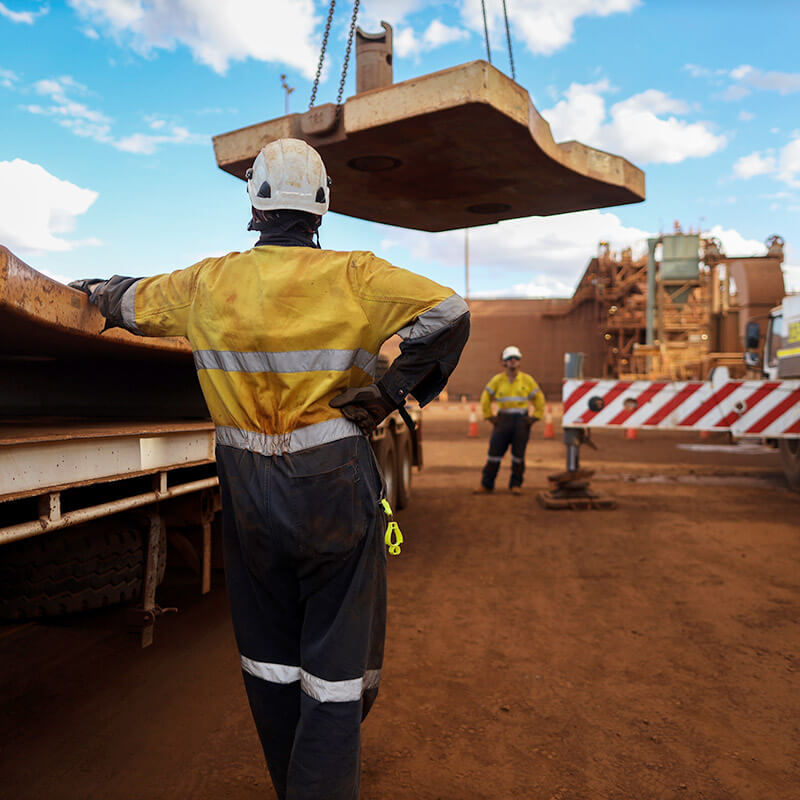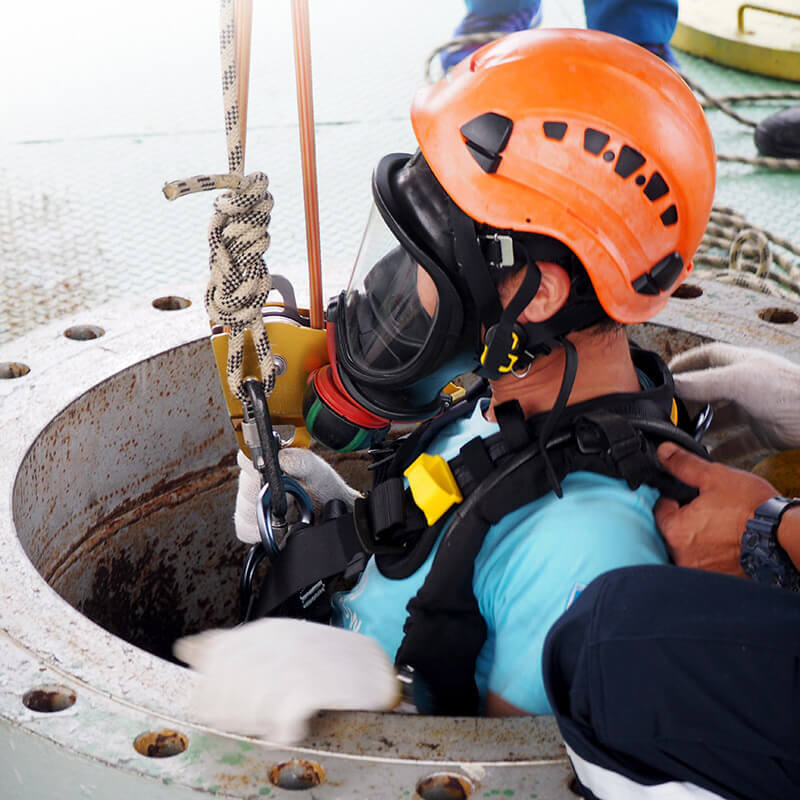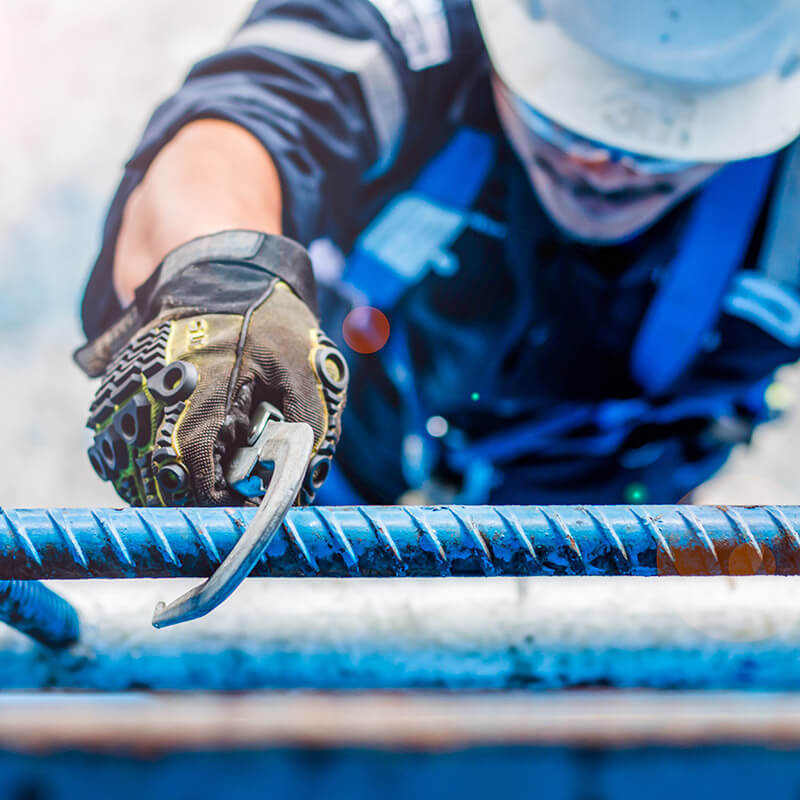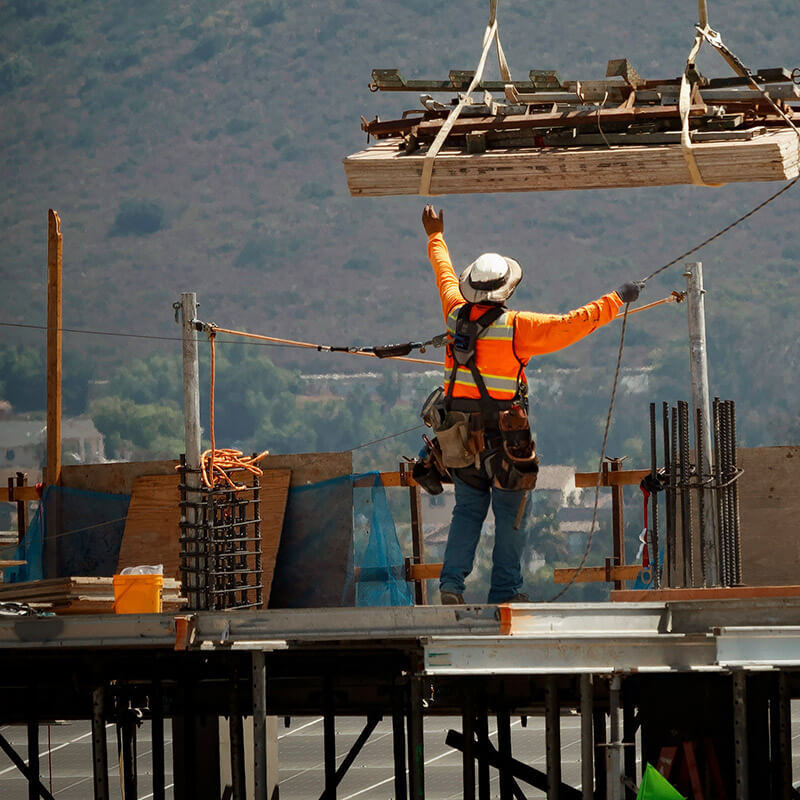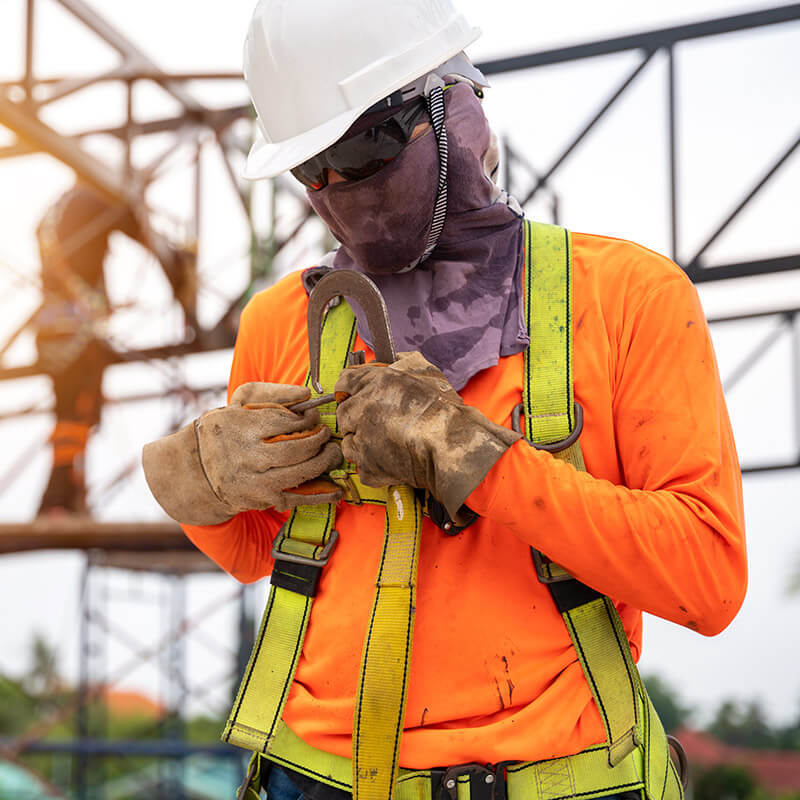What are Self-Retracting Lifelines?
Self-retracting lifelines (SRLs)—also referred to as self-retracting lanyards—are critical safety devices in the construction industry, designed to prevent falls from heights above six feet. Falls remain the leading cause of fatalities in this sector, making the need for robust fall protection systems paramount. SRLs are integral in personal fall arrest systems, offering significant safety advantages by allowing mobility within a work area while maintaining constant tension to avert falls.
In the event of a fall or sudden movement, an internal braking mechanism activates, arresting the fall and distributing the fall force across a short distance. This controlled deceleration significantly mitigates injury risks, highlighting the essential role of SRLs in workplace safety. These lifelines can extend between 30 to 50 feet, offering greater length than traditional fall protection lanyards, and ensure that the force applied to a user's body during a fall is limited to approximately 900 pounds.
Key Takeaways
- Falls are the leading cause of death in the construction industry, making self-retracting lifelines crucial for fall protection.
- Workers at heights above six feet are at higher risk of critical injury or death.
- Self-retracting lifelines (SRLs) are more versatile and longer in length than traditional fall protection lanyards, extending up to 50 feet.
- SRLs are designed to limit the force applied to a user's body during a fall to approximately 900 pounds.
- Modern SRLs are lightweight and portable, weighing just a couple of pounds, making them easier to use and maintain.
Self-Retracting Lifeline Definition and Mechanism
Self-retracting lifelines (SRLs) constitute an essential component in modern fall protection systems, significantly reducing workplace injuries, especially in the construction industry. Understanding the self-retracting lifeline definition and its underlying mechanism is crucial for enhancing workplace safety.
Introduction to SRLs
Since the early 1960s, SRLs have evolved significantly. One of the earliest key developments was Raymond Fertier's safety elevator invention. Over the years, enhancements such as Kikuchi's portable slow descender and Betcher's 2002 patent, which introduced a unique central brake hub with teeth, have advanced SRL designs. Emphasizing fall arrest, SRLs are essential for mitigating risks associated with working at heights.
How SRLs Work
The self-retracting lifeline mechanism is designed to function seamlessly with a braking mechanism that activates during sudden acceleration. When a fall occurs, the internal pawls of the SRL engage, halting further descent. This action activates the braking mechanism, dispersing the energy generated during the fall. By utilizing friction control, an SRL limits fall forces on the body to approximately 900 pounds, thereby reducing the risk of injury.
Components of an SRL
Modern SRLs comprise several integral components that ensure optimal performance and safety. Key elements include:
- Lifeline: The extendable line, which can be made of webbing, rope, or cable, allowing for movement while working.
- Braking Mechanism: A central brake hub equipped with teeth and centrifugal clutch assembly with pawls that engage during falls or sudden movements.
- Energy Dispersion System: This system employs friction control to limit the impact forces transferred to the user during a fall event.
- Housing: Encasing the internal mechanisms, providing protection and ensuring durability.
These components work in unison to form an effective self-retracting lifeline mechanism, minimizing risk and enhancing fall arrest capabilities. Utilizing a compatible full-body harness that meets ANSI, ASSP, and OSHA standards further ensures worker safety. Overall, the systems are pivotal in industries ranging from manufacturing and construction to transportation and entertainment, emphasizing the importance of using personal fall arrest systems with SRLs.
Different Types of Self-Retracting Lifelines
Several types of self-retracting lifelines (SRLs) cater to various work environments and applications. Choosing the right one depends on the specific work requirements, environmental conditions, and the user's needs.
Webbing or Rope Lifelines
Webbing lifelines and rope lifelines are highly versatile and suitable for general industry applications. These lifelines are advantageous due to their flexibility and ease of use in various scenarios. They are particularly effective in environments where sharp edges and abrasive surfaces are not a significant concern. Industries such as manufacturing, maintenance, and entertainment often use webbing or rope lifelines for activities that involve climbing and ladder work.
Cable Lifelines
Cable lifelines are ideal for construction and utility work, especially where contact with sharp edges and abrasive surfaces is likely. The durable construction of cable lifelines makes them resilient to harsh conditions, providing reliable fall protection in demanding environments. These lifelines are commonly used in transportation, steel production, building maintenance, and mining. The robust design ensures safety during climbing, ladder work, and other activities at height.
Vertical Lifelines
Vertical lifelines are specifically designed for applications where the user works upright, such as on ladders or climbing structures. These lifelines provide a secure anchor point that moves effortlessly with the worker to prevent falls. They are particularly useful in utility work and construction sites where vertical movement is part of the job.
- Construction: Frequent use in skyscraper projects, scaffolding, and other vertical structures.
- Utility Work: Essential for tasks involving power lines and other vertical installations.
- Rescue Operations: High utility in life-saving missions where climbing is involved.
Each type of SRL is designed to protect workers from different hazards and should be chosen based on the specific demands of the job. Whether tackling sharp edges, abrasive surfaces, or requiring mobility for climbing and ladder work, selecting the appropriate SRL ensures optimal safety and compliance with ANSI and OSHA standards.
What are Self-Retracting Lifelines?: Benefits and Use Cases
Self-retracting lifelines (SRLs) offer essential protection in environments where work at height is crucial, such as industrial safety, transportation, manufacturing, building maintenance, and mining. These fall arrest devices provide rapid response and arrest falls effectively, which is critical since falls are the leading cause of death in the construction industry. Workers operating above six feet are particularly at risk, making SRLs indispensable tools to enhance safety.
One of the main benefits of self-retracting lifelines is their ability to limit fall forces to approximately 900 pounds through a friction control mechanism, significantly mitigating injury risks. Additionally, full-body harnesses used with SRLs distribute fall forces evenly across the body, enhancing worker protection and complying with stringent ANSI and ASSP standards, which are more specific than OSHA guidelines.
Another key advantage of self-retracting lifeline usage is the reduction of potential fall distances. SRLs can typically payout up to 30 or even 50 feet and are preferred in scenarios where the anchor point is directly overhead. This configuration offers better fall protection compared to traditional lanyards or rope grabs. In contrast, a fall involving a standard lanyard could result in a distance approaching 20 feet, including the lanyard's length and stretch, thus exposing workers to a higher risk of serious injury or death.
Self-retracting lifelines also prevent the buildup of speed during a fall by halting the release of more rope from the housing once a sudden jerk or stop occurs, functioning similarly to seatbelts. This mechanism not only arrests the fall promptly but also absorbs and distributes the energy or force across the body, reducing the impact and likelihood of injury.
The versatility of SRLs extends to various industries, including steel production, construction, and the entertainment industry, where they are critical for ensuring worker safety. Their low maintenance requirements and robust design make SRLs a reliable and cost-effective solution for fall protection across different applications.
By consistently attaching the SRL to the back D-ring of the harness, workers can achieve optimal fall protection, ensuring that they meet the necessary safety standards and reduce the risk of potentially fatal accidents while working at heights.
Choosing and Maintaining Your SRL
Choosing self-retracting lifelines requires careful consideration of various factors to ensure worker safety. The work type and environment play a significant role in selecting the appropriate SRL. For instance, wire rope lifelines are preferred in high-risk cutting or abrasion environments, while webbing or rope lifelines are ideal for general industry applications.
The line length of an SRL should typically limit the free fall distance to no more than six feet. Additionally, the material and connector type must be compatible with the worker's full-body harness and selected anchorage point to ensure maximum safety.
Maintenance of self-retracting lifelines is crucial for their longevity and effectiveness. Before each use, SRLs should be inspected, and a thorough annual inspection by a qualified fall protection expert is recommended. Proper storage also plays an essential part in self-retracting lifeline maintenance, preventing damage and ensuring they remain in good working condition.
Safe Keeper, a reputable supplier, offers a diverse range of fall protection products, including SRLs that meet or exceed OSHA and ANSI standards. They provide options such as 6-foot to 50-foot SRLs, dual SRLs, lightweight SRLs, leading-edge SRLs, and galvanized cable SRLs to cater to various industry needs.
Employers must ensure the SRLs are rated for the combined weight of the worker and their tools. Adhering to ANSI standards and OSHA regulations, such as those outlined by Diversified Fall Protection, ensures workers are protected effectively against falls from height, which remain a leading cause of death in industries like construction, oil and gas, utilities, mining, and general industry.
Conclusion
Self-retracting lifelines (SRLs) play a critical role in workplace safety, particularly in high-risk industries such as construction, mining, and oil and gas. Given that in 2020, one-fifth of all workplace deaths in the United States occurred in the construction industry—with over one-third of these resulting from falls to a lower level—it’s evident how crucial fall protection is. With their ability to arrest falls quickly and effectively, SRLs have become an essential aspect of personal fall arrest systems.
The development of SRL standards has evolved significantly since the American National Standards Institute (ANSI) first released the Z359 standard in 1992. The most recent update, Z359.14-2021, includes categorization and detailed requirements for self-retracting devices, ensuring these fall protection systems meet rigorous safety criteria. This includes Class 1 SRDs for overhead anchorages and Class 2 SRDs for situations where such anchorages are unavailable, offering a tailored approach to different fall hazards.
By adopting self-retracting lifelines and adhering to the latest ANSI standards, industries can vastly improve their fall protection protocols. These devices not only enhance safety by limiting fall distance and distributing the arrest forces across the body but also contribute to greater mobility and reliability. As we continue to prioritize workplace safety, choosing and maintaining the appropriate SRLs becomes indispensable, ensuring protection for workers in diverse environments, thus reducing the risk of injuries and fatalities significantly.
If you are in need of Self-retracting lifelines (SRLs) and other rigging equipment solutions we have many trusted brands like Palmer Safety SRLs in stock and ready to ship.
What’s the Best Material for Rigging?
Dec 18th 2025
What Is the 10-Foot Rule for Rigging?
Dec 15th 2025
What Are the Different Types of Climbing Ropes?
Dec 11th 2025
What Type of Rope Is Best for Climbing?
Dec 9th 2025
What Are the Two Types of Kernmantle Rope?
Nov 25th 2025
What Is a Kernmantle Rope Used For?
Nov 21st 2025
What Is a Fall Protection Harness?
Nov 14th 2025
What are the four components of a PFAS?
Nov 7th 2025
Is Palmer Safety OSHA Compliant?
Nov 3rd 2025




